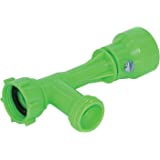mcgeebc
Well-Known Member
I love the smell of brewing, but not everyone in the house agrees. Does this method help eliminate the steam and the smell?

The steam... yes. The smell... somewhat. It won't eliminate it entirely.I love the smell of brewing, but not everyone in the house agrees. Does this method help eliminate the steam and the smell?










![Craft A Brew - Safale S-04 Dry Yeast - Fermentis - English Ale Dry Yeast - For English and American Ales and Hard Apple Ciders - Ingredients for Home Brewing - Beer Making Supplies - [1 Pack]](https://m.media-amazon.com/images/I/41fVGNh6JfL._SL500_.jpg)

@Dockside_Brewing, I look forward to hearing how that beer turns out and if all the DMS gets expelled. The steam condenser is the last thing I'll be purchasing for my system so I'll wait for you feed back before I proceed. Going with a 6" to 2" reducer is probably over kill and I could easily get away with using a 1.5" TC.
Will you be mounting this to the lid or the side of you brew kettle?
this is an extremely interesting thread. I to am eagerly awaiting results from the test batches, though don't really brew a lot of lagers and helles, so it may not matter as much to me. I'll likely try buy a flat lid for my keggle that i could cut in half and solder some stainless hinges in order to top mount this, and still be able to open (part of) the lid for hop additions etc. unless anyone has a good line on a hinged stainless lid. time to start searching alibaba...

According to the company that sells this one 200gal/hr or 3.3 gal/min.What is the water flow rate through this?
According to the company that sells this one 200gal/hr or 3.3 gal/min.
http://www.innomax.com/index2.php?crn=193
I just reread my post and realized how stupid that is.The sprayer we are proposing uses <10 gal/hour. I think it would be tough to justify dumping 200 gallons of water over the course of the boil.

What nozzle did you use (6 or 9 gph @40 psi)? Do you know what your home water pressure is?
The key is the water exiting the drain is very hot, as in just below boiling. If it is too cold, the misting from the nozzle is either inefficient, in which case some of the steam will not get converted, or the flow is too high, which is just wasting extra water. I used the 9 gph but I think I am going to go back to the 6 as I think I get more efficient misting with the 6. My home water pressure is probably around 30 psi.
@Dockside_Brewing the pictures of your brewery are incredible, nice work! Unboxing the Nano from CO Brewing My 25 gal kettle has a lip around the outside of it. So the top of the hole will be down approximately 2" from the top of the kettle? Do you guys see any problems with that? I'm not worried about wort level during the boil, I do 10 gal batches. May have to have it closed off with a blank when I'm mashing a big beer, but that shouldn't be a problem.
View attachment 550161